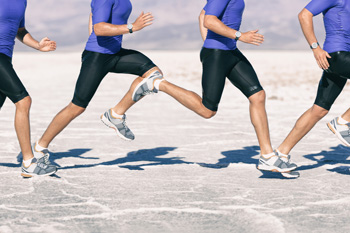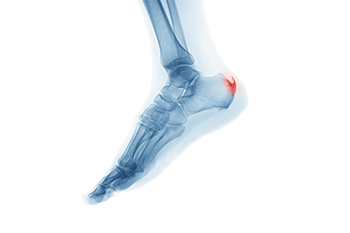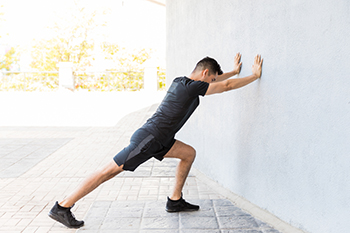June 2022
The Ankle and How It Moves

Understanding foot and ankle biomechanics can be helpful in maximizing the completion of everyday activities. Simply put, it is the way a person walks, moves, or runs. Gait is a style of walking and can involve different stages of movement. There are three components to the foot. The hindfoot is under the ankle joint. This is referred to as the back of the foot and is composed of two tarsal bones. The middle of the foot is known as the mid foot, as its name implies. This part of the foot contains five tarsal bones. Chopart’s joint is the name given where the midfoot and hindfoot connect. The front of the foot is known as the forefoot and includes the metatarsals, phalanges, and sesamoid bone. Each foot consists of 28 bones, and several ligaments, tendons, and muscles. They work together in absorbing shock and creating movement from the heels to the toes. The muscles in the back and front of the leg allow the foot to move up and down and there are specific muscles that enable the foot to point and flex. If you would like to learn additional information about what proper foot structure is responsible for, please consult with a podiatrist.
If you have any concerns about your feet, contact Corinne R. Kauderer, DPM from Dyker Heights Foot & Ankle. Our doctor can provide the care you need to keep you pain-free and on your feet.
Biomechanics in Podiatry
Podiatric biomechanics is a particular sector of specialty podiatry with licensed practitioners who are trained to diagnose and treat conditions affecting the foot, ankle and lower leg. Biomechanics deals with the forces that act against the body, causing an interference with the biological structures. It focuses on the movement of the ankle, the foot and the forces that interact with them.
A History of Biomechanics
- Biomechanics dates back to the BC era in Egypt where evidence of professional foot care has been recorded.
- In 1974, biomechanics gained a higher profile from the studies of Merton Root, who claimed that by changing or controlling the forces between the ankle and the foot, corrections or conditions could be implemented to gain strength and coordination in the area.
Modern technological improvements are based on past theories and therapeutic processes that provide a better understanding of podiatric concepts for biomechanics. Computers can provide accurate information about the forces and patterns of the feet and lower legs.
Understanding biomechanics of the feet can help improve and eliminate pain, stopping further stress to the foot.
If you have any questions please feel free to contact one of our offices located in Brooklyn, NY and Old Bridge, NJ . We offer the newest diagnostic and treatment technologies for all your foot and ankle needs.
What Exactly Is a Heel Spur?

Patients who have heel spurs may describe the feeling as stepping on a thumb tack. The pain may be worse in the morning upon arising and it is often difficult to walk. A heel spur is defined as a bony protrusion that develops on the bottom of the heel and can be diagnosed by having an X-ray performed. Common symptoms that many patients experience can include pain that travels from the heel to the lower leg and the affected heel may feel warm. It can gradually develop as a result of standing on hard surfaces for extended periods or from wearing shoes that do not fit correctly. Many people who have heel spurs also have an inflamed plantar fascia, which is the band of tissue that connects the heels to the toes. These two conditions have similar symptoms and need to be properly diagnosed for effective treatment to begin. Mild relief may come from taking frequent breaks and elevating the feet, and it can help to massage the heel. Different types of shoes may need to be purchased that can accommodate the heel spur and provide additional comfort. If you have a heel spur, please consult with a podiatrist who can offer the best treatment options for you which may include surgery.
Heel spurs can be incredibly painful and sometimes may make you unable to participate in physical activities. To get medical care for your heel spurs, contact Corinne R. Kauderer, DPM from Dyker Heights Foot & Ankle. Our doctor will do everything possible to treat your condition.
Heels Spurs
Heel spurs are formed by calcium deposits on the back of the foot where the heel is. This can also be caused by small fragments of bone breaking off one section of the foot, attaching onto the back of the foot. Heel spurs can also be bone growth on the back of the foot and may grow in the direction of the arch of the foot.
Older individuals usually suffer from heel spurs and pain sometimes intensifies with age. One of the main condition's spurs are related to is plantar fasciitis.
Pain
The pain associated with spurs is often because of weight placed on the feet. When someone is walking, their entire weight is concentrated on the feet. Bone spurs then have the tendency to affect other bones and tissues around the foot. As the pain continues, the feet will become tender and sensitive over time.
Treatments
There are many ways to treat heel spurs. If one is suffering from heel spurs in conjunction with pain, there are several methods for healing. Medication, surgery, and herbal care are some options.
If you have any questions feel free to contact one of our offices located in Brooklyn, NY and Old Bridge, NJ . We offer the latest in diagnostic and treatment technology to meet your needs.
Ingrown Toenails in Children

Ingrown toenails or onychocryptosis is a common nail disorder that can affect children. With this condition, the toenail grows into the skin surrounding the nail. Since the nail cuts the skin, the area can become inflamed or irritated, and an infection may develop. Not only can the child feel pain when pressure is applied to the toenail, but it may also be painful to walk and participate in activities. An ingrown toenail is often the result of toenails being cut improperly or shoes that compress a child’s big toe. Other causes may be abnormalities in nail formation causing the toenail to grow inward instead of outward, a sports injury, or genetics. If your child has an ingrown toenail, especially if it appears infected or there is drainage, make an appointment with a podiatrist to have their foot checked and the proper treatment administered.
The health of a child’s feet is vital to their overall well-being. If you have any questions regarding foot health, contact Corinne R. Kauderer, DPM of Dyker Heights Foot & Ankle. Our doctor can provide the care you need to keep you pain-free and on your feet.
Tips for Keeping Children's Feet Healthy
- Make sure their shoes fit properly
- Look for any signs of in-toeing or out-toeing
- Check to see if they have Clubfoot (condition that affects your child’s foot and ankle, twisting the heel and toes inward) which is one of the most common nonmajor birth defects.
- Lightly cover your baby’s feet (Tight covers may keep your baby from moving their feet freely, and could prevent normal development)
- Allow your toddler to go shoeless (Shoes can be restricting for a young child’s foot)
- Cut toenails straight across to avoid ingrown toenails
- Keep your child’s foot clean and dry
- Cover cuts and scrapes. Wash any scratches with soap and water and cover them with a bandage until they’ve healed.
If you have any questions, please feel free to contact one of our offices located in Brooklyn, NY and Old Bridge, NJ . We offer the newest diagnostic and treatment technologies for all your foot care needs.
Why Live with Pain and Numbness in Your Feet?
When Athletes Injure Their Posterior Tibial Tendon

The posterior tibial tendon is an important tendon in the leg. It attaches the posterior tibial muscle in the back of the calf to bones located on the inside of the foot. It helps to support the arch and foot when walking and is necessary for pointing the foot down or in, which can be frequent for runners and other athletes. Dysfunction of the posterior tibial tendon commonly occurs over time because of wear and tear, or by excessively flattening the feet and rolling inward when walking known as overpronation. A common injury many athletes may face is posterior tibial tendinopathy, which is either inflammation of the tendon (tendonitis) or gradual degeneration of the tendon (tendinosis). Pain can be felt in the back of the ankle near the inside of the foot that sometimes travels upward to the inside of the calf muscle. This pain may worsen when you lift the foot up or walk. You are encouraged to contact a podiatrist if you believe you have suffered an injury to your posterior tibial tendon. They have a variety of effective anti-inflammatory and immobilization techniques to help the tendon heal and relieve your pain.
Ankle and foot injuries are common among athletes and in many sports. They can be caused by several problems and may be potentially serious. If you are feeling pain or think you were injured in a sporting event or when exercising, consult with Corinne R. Kauderer, DPM from Dyker Heights Foot & Ankle. Our doctor will assess your condition and provide you with quality foot and ankle treatment.
Common Injuries
The most common injuries that occur in sporting activities include:
- Achilles Tendonitis
- Achilles Tendon Rupture
- Ankle Sprains
- Broken Foot
- Plantar Fasciitis
- Stress Fractures
- Turf Toe
Symptoms
Symptoms vary depending upon the injury and in some cases, there may be no symptoms at all. However, in most cases, some form of symptom is experienced. Pain, aching, burning, bruising, tenderness, tightness or stiffness, sensation loss, difficulty moving, and swelling are the most common symptoms.
Treatment
Just as symptoms vary depending upon the injury, so do treatment options. A common treatment method is known as the RICE method. This method involves rest, applying ice, compression and elevating the afflicted foot or ankle. If the injury appears to be more serious, surgery might be required, such as arthroscopic or reconstructive surgery. Lastly, rehabilitation or therapy might be needed to gain full functionality in the afflicted area. Any discomfort experienced by an athlete must be evaluated by a licensed, reputable medical professional.
If you have any questions, please feel free to contact one of our offices located in Brooklyn, NY and Old Bridge, NJ . We offer the newest diagnostic and treatment technologies for all your foot care needs.








